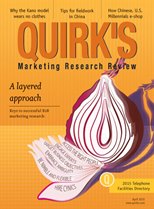Marketing research and insights news and information. This issue's keywords: smartphones; wireless-only households; new car recommendations; increasing diversity in America; industrial robots
Ninety-two percent of 1,000 respondents said smartphones have changed the way they connect with friends, 58 percent believe smartphones have changed how they manage their health and 49 percent say smartphones have changed the way they date according to a survey of smartphone users by San Jose, Calif. analytics technology firm Apigee. The firm has quantified how much smartphones have become part of daily life. Respondents also credited smartphones with changing how they shop (84 percent), bank (78 percent) and watch television and movies (70 percent). Apigee noted that the use of mobile apps has increased consumer expectations, with survey respondents saying they expect updates and services via apps from their banks, department stores, restaurants, grocery stores and even their church. The study was conducted in October 2014 and included 1,000 people selected by age, income, education and gender distribution to reflect the U.S. and U.K. smartphone market. The complete report can be found at apigee.com/about/press-releases.
Landlines are operational in only half of U.S. households, according to a report from New York statistics firm Statista. That is a dramatic decrease from 2005, when nine in 10 households still had a working wired telephone network connection. The data comes from the biannual National Health Interview Survey, which has been conducted by the Centers for Disease Control and Prevention (CDC) since 2004. The data also reveals that more than four in 10 households have only mobile phones and that more than half of adults aged 18 to 44 and children under 18 were living in wireless-only households.
Social media may be popular for restaurant recommendations but it’s not seen as useful for buying new cars, according to research by MaritzCX, Salt Lake City researcher. When asked the most important source of information in their new car selection, 22 percent of 60,000+ respondents rated the salesperson as most important, followed by friends and family at 19 percent and consumer guides at 14 percent. Social media, defined as Facebook, Google+, LinkedIn and Twitter, was listed by only 0.6 percent. The complete survey, which was conducted from October 2013 to July 2014, is available at cxcafe.maritzcx.com/auto.
The 2015 American Marketscape Datastream report forecasts that the non-Hispanic white population of the U.S. will fall below 50 percent of the total population by 2042. The study published by Miami marketing firm Geoscape, describes an America growing increasingly diverse, with Hispanic, Asian-American and African-American residents accounting for 36 percent of the U.S. population and 39 percent by 2020. Currently there are 372 counties in the U.S. that are “majority-minority,” having a majority of the population comprised of minorities, including many of the most populated areas.
The Boston Consulting Group forecasts that robots will replace human factory workers at a faster pace than expected and that investment in industrial robots will grow 10 percent a year through 2025, up from the current 2 to 3 percent. While robots now handle 10 percent of automated jobs, this will increase to more than 23 percent by 2025, predicts Boston Consulting. The costs of owning and operating robots are dropping and new models can handle more types of tasks. Robots are predicted to cut labor costs by 33 percent in South Korea, 25 percent in Japan, 24 percent in Canada and 22 percent in the U.S.
These reports were compiled from recent issues of the Daily News Queue, a free e-newsletter digest of marketing research and insights news and information delivered each business morning. Not already in the Queue? Sign up here!
